
Around the world, researchers like Howes are investigating how nonvisual information defines the character of a city and affects its livability. Using methods ranging from low-tech sound walks and smell maps to data scraping, wearables, and virtual reality, they’re fighting what they see as a limiting visual bias in urban planning.
“Just being able to close your eyes for 10 minutes gives you a totally different feeling about a place,” says O?uz Öner, an academic and musician.
Öner has spent years organizing sound walks in Istanbul where blindfolded participants describe what they hear at different spots. His research has identified locations where vegetation could be planted to dampen traffic noise or where a wave organ could be constructed to amplify the soothing sounds of the sea, something he was surprised to realize people could hardly hear, even along the waterfront.
Local officials have expressed interest in his findings, Öner says, but have not yet incorporated them into urban plans. But this kind of individual feedback about the sensory environment is already being put to use in Berlin, where quiet areas identified by citizens using a free mobile app have been included in the city’s latest noise action plan. Under EU law, the city is now obligated to protect these spaces against an increase in noise.
“The way quiet areas are identified is usually very top-down, either based on land use or high-level parameters like distance from highways,” explains Francesco Aletta, a research associate at University College London. “This is the first example I’m aware of something perception-driven becoming policy.”
As a member of the EU-funded Soundscape Indices project, Aletta is helping create prediction models for how people will respond to various acoustic environments by compiling recorded soundscapes, both vibrant and tranquil, into a database and then testing the neural and physiological reactions they elicit. These kinds of tools are what experts say are needed to create a practical framework for ensuring that multisensory elements are included in design criteria and planning processes for cities.
The best way to determine how people react to different sensory environments is a subject of some debate within the field. Howes and his colleagues are taking a more ethnographic approach, using observation and interviews to develop a set of best practices for good sensory design in public spaces. Other researchers are going more high-tech, using wearables to track biometric data like heart-rate variability as a proxy for emotional responses to different sensory experiences. The EU-funded GoGreen Routes project is looking to that approach as it studies how nature can be integrated into urban spaces in a way that improves both human and environmental health.
